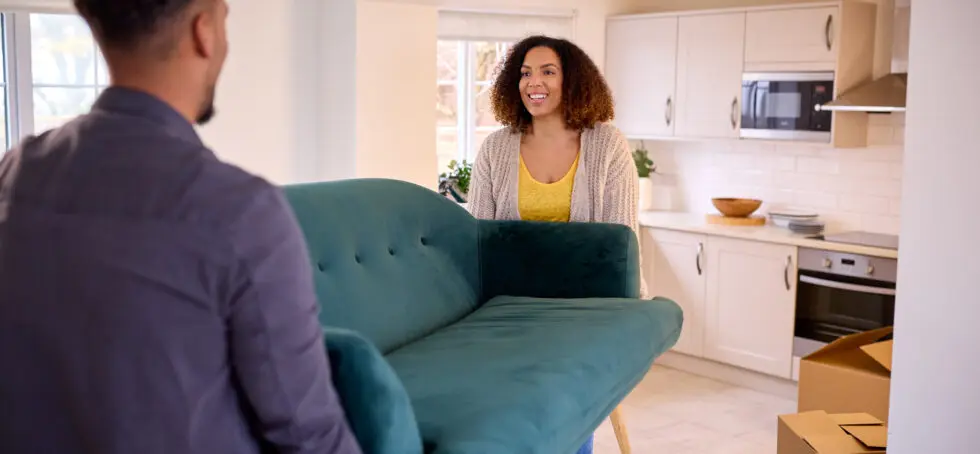Yorkshire Building Society has launched a 99% mortgage that enables first time buyers with a £5,000 deposit to buy a house worth up to £500,000. The same mortgage is also offered through Accord Mortgages, Yorkshire Building Society’s broker-only arm. But is it right for you? We weigh up the pros and cons.
What is a 1% deposit mortgage?
A 1% deposit mortgage means you’ll only need to put down 1% of the value of the property you’re buying as a deposit.
- For example, if you’re buying a property that costs £500,000, with a 1% deposit mortgage you would need a deposit of £5,000 and you’d take out a 99% mortgage for the remaining £495,000.
- By comparison, if you took out a 95% mortgage, you’d need a 5% deposit of £25,000 and you’d take out a mortgage for £475,000. While if you took out a 90% mortgage, you’d need a £50,000 deposit and a mortgage of £450,000.
Yorkshire Building Society’s 1% deposit mortgage
The Yorkshire Building Society 1% deposit mortgage – also being marketed as the “£5,000 deposit mortgage” – is a 5 year fixed-rate mortgage available at a rate of 5.99%. It does have some eligibility criteria:
- At least one applicant must be a first time buyers
- There is a maximum term of 40 years
- For purchase of houses only (no flats or new builds)
- The maximum age allowable at the end of the term is 70
- An enhanced credit score must be achieved for applicant(s) to be eligible for the product
It’s also important to note that there is a minimum £5k deposit whether you borrow between £100k or £495k. So it is only really a 1% deposit mortgage if you take out the maximum loan size of £495,000.
You can check what you can afford to borrow now, using our fee-free mortgage partners at L&C. They can check what deals are available, how much you would be able to borrow and find out how much it would cost you in monthly repayments.
Mortgage Finder
Get fee free mortgage advice from our partners at L&C. Use the online mortgage finder or speak to an advisor today.
Find a mortgage
What are the benefits of a 1% deposit mortgage?
High house prices and saving for a deposit are the major barriers faced by first time buyers. Many people who are renting feel stuck: they’re paying such high amounts in rent that while they could afford a mortgage, they don’t have enough spare money to build up a big enough deposit to buy a house. For those people, getting a 1% deposit mortgage could make buying a home possible for them.
David Hollingworth, associate director at L&C Mortgages says that 1% mortgages: ‘…would likely open up an alternative option for first time buyers struggling to build a deposit. Requiring a smaller deposit could help accelerate the ability to buy, for those that can fund the remainder from mortgage borrowing.’
What are the downsides of a 1% deposit mortgages?
But there are downsides of a 1% deposit mortgages to consider carefully including the risk of going into negative equity, higher mortgage rates, and affordability of the mortgage. Lets look at these:
Risk of negative equity
You’re in negative equity when the value of your mortgage is bigger than the value of your property. And it’s not uncommon: according to MoneyHelper, it’s estimated there’s around half a million properties in negative equity in the UK. The smaller the deposit you put down, the greater the risk of negative equity if the value of your property falls.
For example, if you buy a property for £500,000 and take out a £495,000 mortgage. If the value of your property falls to £490,000 you would be in negative equity. By comparison, if you took out a 95% mortgage and borrowed £475,000 or a 90% mortgage and borrowed £450,000 while you would have less equity in your home you wouldn’t be in negative equity. Read our guide What can I do about negative equity?
It’s important then to think about what happens when your 1% deposit mortgage deal ends? Yorkshire Building Society’s 1% mortgage requires you to take the mortgage out for 5 years. This is the same as Skipton Building Society’s 100% mortgage. The idea is that someone will have built up a good chunk of equity over the 5 years, hopefully making it easier to remortgage onto a lower LTV mortgage – but this isn’t guaranteed. While the mortgage is portable, no additional lending will be allowed until there is a reduction in LTV to under 95% LTV.
Higher mortgage rates
The higher risk a lender views you, the higher the mortgage rate you’ll usually pay. In other words, the less of your own money you put up as a deposit, the higher the mortgage rate the lender is likely to offer you as you’re a greater risk than someone who, for example, can stump up a 5% deposit.
Affordability
Saving for a deposit isn’t the only barrier first time buyers face – you’ll need to be able to borrow a big enough mortgage based on your financial circumstances. As a rule of thumb, most lenders will offer a maximum of 4.5 times a first time buyer’s annual income.
So if you wanted to borrow the maximum amount offered through the Yorkshire Building Society mortgage of £495,000 to buy a £500,000 house with a 1% deposit mortgage, you’d typically need a minimum salary of £110,000. If you want to borrow less than £495,000 you’ll need a smaller minimum salary, but you’ll still need a £5,000 deposit so it won’t be a 1 per cent mortgage.
However, this will vary by lender so to get advice tailored to your circumstances, it’s advisable to speak to a fee-free mortgage broker. Also, read our guide How much can I afford to borrow on a mortgage?
Other buying costs
There are other fees you’ll need to budget for when buying a house such as conveyancing fees and the cost of a survey too. Plus you may need to pay stamp duty too. Find out more in our guide The costs of buying a house.
99% mortgages and house prices
When the rumours that the government was planning a 1% deposit mortgage scheme were reported, many experts voiced concerns that a 1 percent deposit mortgage scheme will lead to more people buying, which would over-stimulate the market and increase demand for housing.
How popular are 1% deposit mortgages likely to be?
There have been a lot of headlines around the possibility of 1% deposit mortgages. However, according to figures from Halifax, in 2023, the average deposit put down on a first home was £54,116 – around 19% of the property price. It’s clear that most first time buyers understand the benefit of a bigger deposit, allowing them to access cheaper mortgage rates which in turn make their monthly repayments more affordable. So many first time buyers may be reluctant to take out such a low deposit mortgage.
However, it’s very likely that there will be potential first time buyers who are currently locked out of being able to buy a home, who will find this scheme appealing.
What are the alternatives to 1% deposit mortgages?
If you have a small deposit, the government has a range of other schemes to help you afford to buy your home. These include:
- Shared Ownership. But there are pros cons to this complicated scheme, so we’d always recommend buying on the open market if you can.
- The First Homes Scheme where you may be able buy a home for 30% to 50% less than its market value when you meet certain criteria (although qualifying properties are very scarce).
- While not a government scheme, the Own New rate reducer scheme allows you to buy a new build home with a mortgage and pay a lower mortgage rate than if you buy on the open market with a traditional mortgage. The ways this works is that when you choose your property, the developer will agree to contribute up to 5% of the purchase price and this is used to give you a reduction off your monthly mortgage payments for the first 2 or 5 years. Find out more in our guide Own New scheme explained.
- Deposit Unlock is a new scheme developed by the House Builders Federation to help first time buyers and home movers buy a new build home with just a 5% deposit. Again, a 95% mortgage on the open market would be preferable to this scheme which limits you to a new build.
There are more options if you can turn to the ‘Bank of Mum and Dad’ for help, such as:
- Guarantor mortgages: This is when a loved one, usually a parent, takes on some of the mortgage’s risk by acting as a guarantor. This usually means them offering their savings or their home as security against the loan and committing to making the mortgage payments if the borrower defaults. For more information read our guide on Guarantor mortgages explained.
- Family offset mortgages: These work in a similar way to guarantor mortgages that use savings as security. Although the main difference is that your loved one won’t earn interest on their savings. But on the flip side, as it’s an offset mortgage, you will only pay interest on the difference between the total value of the mortgage and the value of the savings held in the linked savings account.
- Gifted Deposit – this is the ultimate way to boost your deposit, with a no-strings attach gift from parents or relatives to help you get on the ladder. Count your lucky stars if this is you.
Mortgage Finder
Get fee free mortgage advice from our partners at L&C. Use the online mortgage finder or speak to an advisor today.
Find a mortgage








